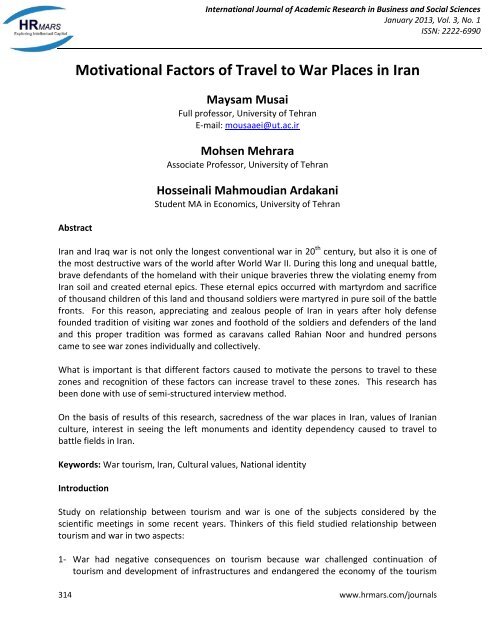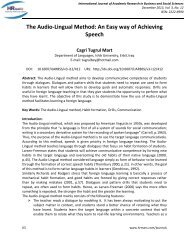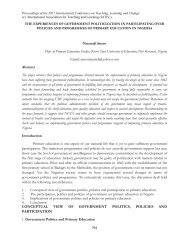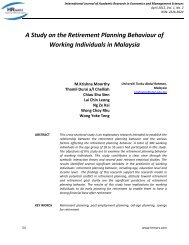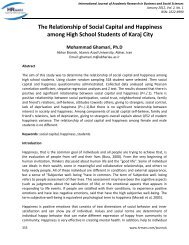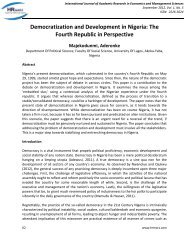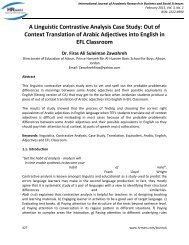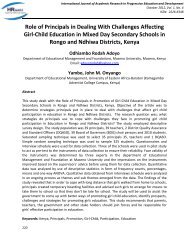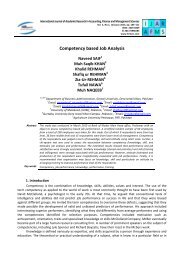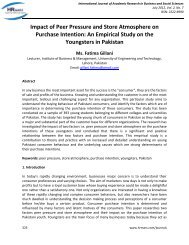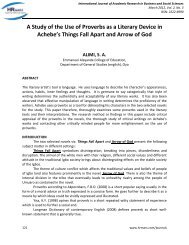Abstract - Human Resource Management Academic Research Society
Abstract - Human Resource Management Academic Research Society
Abstract - Human Resource Management Academic Research Society
Create successful ePaper yourself
Turn your PDF publications into a flip-book with our unique Google optimized e-Paper software.
International Journal of <strong>Academic</strong> <strong>Research</strong> in Business and Social Sciences<br />
January 2013, Vol. 3, No. 1<br />
ISSN: 2222-6990<br />
<strong>Abstract</strong><br />
Motivational Factors of Travel to War Places in Iran<br />
Maysam Musai<br />
Full professor, University of Tehran<br />
E-mail: mousaaei@ut.ac.ir<br />
Mohsen Mehrara<br />
Associate Professor, University of Tehran<br />
Hosseinali Mahmoudian Ardakani<br />
Student MA in Economics, University of Tehran<br />
Iran and Iraq war is not only the longest conventional war in 20 th century, but also it is one of<br />
the most destructive wars of the world after World War II. During this long and unequal battle,<br />
brave defendants of the homeland with their unique braveries threw the violating enemy from<br />
Iran soil and created eternal epics. These eternal epics occurred with martyrdom and sacrifice<br />
of thousand children of this land and thousand soldiers were martyred in pure soil of the battle<br />
fronts. For this reason, appreciating and zealous people of Iran in years after holy defense<br />
founded tradition of visiting war zones and foothold of the soldiers and defenders of the land<br />
and this proper tradition was formed as caravans called Rahian Noor and hundred persons<br />
came to see war zones individually and collectively.<br />
What is important is that different factors caused to motivate the persons to travel to these<br />
zones and recognition of these factors can increase travel to these zones. This research has<br />
been done with use of semi-structured interview method.<br />
On the basis of results of this research, sacredness of the war places in Iran, values of Iranian<br />
culture, interest in seeing the left monuments and identity dependency caused to travel to<br />
battle fields in Iran.<br />
Keywords: War tourism, Iran, Cultural values, National identity<br />
Introduction<br />
Study on relationship between tourism and war is one of the subjects considered by the<br />
scientific meetings in some recent years. Thinkers of this field studied relationship between<br />
tourism and war in two aspects:<br />
1- War had negative consequences on tourism because war challenged continuation of<br />
tourism and development of infrastructures and endangered the economy of the tourism<br />
314 www.hrmars.com/journals
International Journal of <strong>Academic</strong> <strong>Research</strong> in Business and Social Sciences<br />
January 2013, Vol. 3, No. 1<br />
ISSN: 2222-6990<br />
based zones. In fact, as the tourism is able to allow economic variety and growth, war<br />
destroys all buildings in short term.<br />
2- The second relation is tourism after war. The left monuments of war are regarded as<br />
national heritage in many countries and turned into tourism charisma because war is not<br />
only bitter time, place and event, but also is an event which changes all structure of a nation<br />
or some countries. For this reason, honors, war zones, monuments, glorification ceremony<br />
of the soldiers, the prisoners etc can be converted to important motivational factors in<br />
tourism. Today, war tourism has many proponents in the world and millions of persons in<br />
different parts of the world visit war tourism charismas. This part of tourism industry in the<br />
world has been developed rapidly and many investments are made in different countries of<br />
the world in this field.<br />
Speed of tourism growth and visiting war zones in Iran is higher than that of all kinds of tourism<br />
which has considered in its development. On the basis of informal statistics, about 5 million<br />
persons visit these zones every year. But scientific research has been done in this regard.<br />
Therefore, it is necessary to do broad studies.<br />
Review of Literature<br />
Phenomenon of travel to the places of death and catastrophe has long record. Siton (1992)<br />
declares that tourism followed mortality since Gladiators and their competitions in Ancient<br />
Rome. Its footstep can be found in middle Ages and pilgrimage travels in places of punishment<br />
and capital punishment. Term Dark tourism was introduced by Professor John Lennon and<br />
Malcolm Noli for the first time in middle 1990s in Glasgow University.<br />
Lennon and Foni studied different sites and places of dark tourism heritage all over the world.<br />
Battle fields and war fronts, war representation, borders, formalities, tradition and customs<br />
museum, exhibits to tombs and monuments and studied different fields and interpreted and<br />
constructed these places, war, death, terror, murder, genocide, slavery, fear and terror.<br />
Although work of these two persons was a new subject in tourism, it lacked strong and firm<br />
theoretical framework and dealt with attitude and view of suppliers and didn’t include status of<br />
the consumers. We should note that since concept of dark tourism is subset of many types of<br />
tourism such as cultural, historical and heritage tourism, it is difficult to define and explain it.<br />
Therefore, dark tourism is a complex branch of tourism.<br />
In tourism research, travels which relate to death, adversity, and cruelty, catastrophe and<br />
disaster were studied with different names of which the most balanced one is dark tourism.<br />
Other names such as mortality tourism, grief tourism, dark tourism, fear tourism, disaster<br />
tourism, and cruelty heritage tourism have been raised. However, there is no clear definition in<br />
each field.<br />
War challenges have been studied as tourism charisma in many internal war sites in USA<br />
(Abroe, 1998; Hanink & Stutts , 2002; Greene, 1990) as well as the in places relating to World<br />
Wars of 20 th century (Franza & Johnson, 1994; Martinez, 1992; Charleton, 1991; Siton, 2000 and<br />
315 www.hrmars.com/journals
International Journal of <strong>Academic</strong> <strong>Research</strong> in Business and Social Sciences<br />
January 2013, Vol. 3, No. 1<br />
ISSN: 2222-6990<br />
1999; Edwards, 2000; Slade, 2004). Vietnam War tourism sites have been important in these<br />
fields (Henderson, 2000). In Europe, interpretation of war and conflict has longer record. Use of<br />
emotional approach for interpretation of the past events relates to interoperation of<br />
controvertible interpretation (Uzzell, 1989).<br />
In study on the reasons for travel of the tourists to the war zones, motivations have been<br />
considered compulsory and critical element in study on dark tourism or mortality tourism. On<br />
this basis, they presented models regarding motivations of the tourist. These models are as<br />
follows:<br />
Plog Typology<br />
Plog (19740 discusses that character and motivation of the persons are related to each other.<br />
The writer divides character into two psycho centric and allocentric types. Psycho centric type<br />
relates to depressed, repressed, nervous and non-adventurous character. Relaxation and<br />
tranquility are their main motivations. On the other hand, the allocentric persons are<br />
adventurous and self confident persons. At time of travel, they are more absorbed by nontouristic<br />
zones so that they can have new experience and exploration and communicate with<br />
the persons from the strange and deserted zones. Plog typology provides important insights<br />
and views for study of the tourists’ motivation in tourism generally and dark tourism<br />
particularly. For example, Tarlow believes that dark tourism is a type of spiritual tourism which<br />
is affected by nostalgia. He suggests that the person who seeks tourism nostalgia will move<br />
toward psycho centric type of Plog. Therefore, dark tourism should be presented in a method<br />
which mixes history with hazards to absorb allocentric group of the passengers.<br />
The Push and Pull Model<br />
One of the common models relating to motivation of tourists in research and study is Dan’s<br />
push and pull model. On the basis of Dan’s views, pushing factors are those which direct tourist<br />
to recreational places such as sunshine, sea etc and the values which are seen so that passenger<br />
resides therewith that purpose. On the contrary, the pulling factors related to the subjects<br />
which encouraged passenger to travel such as escape from routine work, nostalgia of the past<br />
etc. Dan believes that problem of motivation will be easily solved with concentration on pulling<br />
factors.<br />
Crompton (1979) was one of the writers who classified motivations into pushing and pulling<br />
factors and many other writers accepted this approach (for example, Bansal and Eiselt, 2004;<br />
Correia, Oom do Valle & Moco, 2007; Goossens, 2000, Kozak, 2002). Push and pull model was<br />
regarded as standard model for research and investigation of the tourists’ motivations because<br />
this model is clear and it is simple to work with.<br />
316 www.hrmars.com/journals
International Journal of <strong>Academic</strong> <strong>Research</strong> in Business and Social Sciences<br />
January 2013, Vol. 3, No. 1<br />
ISSN: 2222-6990<br />
The Extrinsic and Intrinsic Motivation Typology<br />
With similar approach of Dan (1977), Iso-Ahola (1982) suggests that the reasons of people for<br />
leisure time and tourism can be as follows: searching and escaping. The writer believes that the<br />
factors which motivate the tourist include 1-tendemcy to leave the life environment (extrinsic<br />
factor) and 2- tendency to obtain mental rewards (intrinsic factor) through travel to different<br />
environments. Selection of one or both of them will be effective as main reason for travel in<br />
plans and behaviors of the tourist.<br />
The Travel Career Ladder<br />
Another model is motivation of the tourists which has been well known is travel career ladder<br />
which was created by Peers (1988). He describes five stages of the tourist’s needs bottom up:<br />
need for relaxation and tranquility, need for safety/security, need for communication, need for<br />
self esteem, self confidence and need for achieving the goal. On the basis of Peers’ ideas,<br />
motivation is dynamic and future oriented, is affected by social factors and grows and<br />
motivations of the people change over time. While this model has been accepted, applied and<br />
progressed in different studies, this approach was criticized by the tourism researchers. Rayan<br />
(1998) found that the persons who experienced a destination have more adjustment between<br />
demands and ability to reach their goals.<br />
<strong>Research</strong>ers studied dark tourism motivations with use of the above models which are given in<br />
summary in the following table.<br />
Table –summary of dark tourism motivation studies<br />
Writer Place Motivations<br />
Best (2007) Norfolk island Exploration and historical interests, relaxation,<br />
spending time with friends<br />
Copper (2006) Nagasaki Peace Park Education, monument and curiosity<br />
Ashtoreth<br />
Curiosity, identity, fear and horror and<br />
(2004)<br />
symphony<br />
Slade (2003) Gallipoli National roots<br />
Siton (1999) Waterloo Personal relation with war, recreation and<br />
entertainment<br />
Strange and Ruben island<br />
Learning and exploration<br />
Campa (2003)<br />
Pool (2003) Huston Holocaust<br />
Museum<br />
Monument, education, curiosity, nostalgia,<br />
media, position etc.<br />
In summary, motivation is one of the main factors which are raised at time of asking the dark<br />
tourism charismas visitors. There are different reasons for visiting the places relating to<br />
317 www.hrmars.com/journals
International Journal of <strong>Academic</strong> <strong>Research</strong> in Business and Social Sciences<br />
January 2013, Vol. 3, No. 1<br />
ISSN: 2222-6990<br />
mortality and catastrophe. Although all of the performed studies of dark tourism are not about<br />
battlefields tourism, this finding gives correct attitudes about battlefields tourism motivation.<br />
<strong>Research</strong> Methodology<br />
Information gathering method was qualitative and the sampling in this section is purposeful.<br />
This method doesn’t allow generalization in contrary to the probability sampling. In nonprobability<br />
sampling which was used in this part of research, subjective judgment is used for<br />
selection of the sample. Qualitative sampling wants to be purposeful rather than random.<br />
Qualitative research seeks to find that there is logical coherence and random sampling can<br />
decrease this quality. Therefore, selection of the sample is derived from conceptual questions.<br />
Among the war tourism authorities, the persons were selected who had more familiarity with<br />
behavior and attitude of the visitors.<br />
Findings<br />
Study on personal and social motivational factors in war tourism is one of the important and<br />
complex issues. Many performed studies have dealt with the reasons for formation of war<br />
tourism and broad scope of the factors has been raised. <strong>Research</strong>ers mention the most<br />
important factors among the performed interviews:<br />
1- Sacredness of the war related places<br />
The most important factor which absorbed different classes especially the young to places<br />
relating to holy defense periods such as battlefields, tombs of the martyrs etc is spiritual space.<br />
Perhaps, it is difficult to elaborate such space. But observation of the present persons in Rahian<br />
Noor campaigns confirms such fact. With all persons who have traveled to these destinations<br />
regard them pilgrims who travel to such places with intention of closeness and due to spiritual<br />
need for spiritual space. Type and form of the travels to these regions are different from other<br />
types of travel: simple and light. For this reason, passengers don’t intend to spend leisure time,<br />
especially the students who visit the war zones during the semester. Naming this type of travel<br />
as Rahian Noor and use of some tools such as keffiyeh for similarity to soldiers indicates this<br />
important aspect.<br />
Experts believe that the most important reason for sacredness in such spaces is formation of<br />
war in Iran. Holy defense periods didn’t relate to material or conquest of or demand of the<br />
government but beliefs and ideals of people after Islamic Revolution and trying to destroy the<br />
government and occupy Iran caused the people to defend against violation of Iraq and name it<br />
Holy Defense. In contrary to many wars in the world which confused the soldiers who were<br />
gambling and drinking at their leisure time in the fronts, space of fronts in Iran was full of<br />
praying and worshiping.<br />
With reliance on religious lessons of Islam, martyrdom in the way of God and protecting the<br />
land doesn’t mean death but martyrdom and the martyr has the same position as the prophets<br />
318 www.hrmars.com/journals
International Journal of <strong>Academic</strong> <strong>Research</strong> in Business and Social Sciences<br />
January 2013, Vol. 3, No. 1<br />
ISSN: 2222-6990<br />
and imams have and his afterlife is imagined to be attractive and elevated. Therefore, for those<br />
who learn such concepts, martyrdom is a wish which is realized to get close to God and those<br />
who visit battlefields and remind the martyrs see their wishes to be realized in these persons<br />
and resort to them.<br />
Some researchers believe that deliberating such concepts as a motivation for visiting<br />
battlefields may be due to the comparisons between Iran war and other wars in the world of<br />
which dark point of similarity is more than other points. In many cases, these wars, the martyrs<br />
and the injured are only pitiful and their families are impressed by their martyrdom while<br />
culture of martyrdom in Iran is praised and encouraged. For this reason, spiritual aspect of the<br />
war is more important that dark and glooming aspect.<br />
2- Defending the land, concept of national identity:<br />
In addition to epigeous lessons in Iranian culture, those who defend soil and land against<br />
foreign violations are praised and respected. During history of Iran, this land was attacked by<br />
the foreigners and all of those who have defended the country in different ways far from result<br />
of the wars (victory or defeat) were supported and praised by people. In fact, reminding the<br />
events occurring in the wars and braveries is regarded as symbol of national identity and even<br />
can show glory of the Iranians in contemporary history of the world. Holy defense period led to<br />
victory of Iran as one of the unequal wars in spite of power of the opposing front and is one of<br />
the honorable wars of Iran. Admitting miracle of Iran war as noted by the foreign thinkers such<br />
as Roger Garaudy confirms this fact. Many performed operations during holy defense periods<br />
were out of the classic wars common theories system and many officers of the world liked to<br />
analyze it. All of these specifications are regarded as pride for Iranian identity in addition to<br />
braveries of the soldiers who went to battlefield with empty hands. Many fathers bring their<br />
children to these fields to remind them of some events. Although it is not possible to border<br />
between religious values and Iranian culture values as factors effective on demand of war<br />
tourism, we can refer to both reasons clearly in some cases.<br />
3- Visiting the left monuments of history and national heritage:<br />
With regard to effect of two factors mentioned above, travel of the persons and places to which<br />
they travel depend on attitude of the persons and religious and cultural dependency on the<br />
subject. Many left monuments from the historical periods may not be admired or visited by the<br />
public due to lack of cultural, religious and even national supports, holy defense issue attracts<br />
attention of two groups of visitors with the above supports:<br />
1- The visitors who travel to these regions with strong religious –cultural attitude.<br />
2- The visitors who go to visit the traces of war with nationalistic attitude and emphasis on<br />
Iranian entity.<br />
Visiting relics and events occurring in the countries is one of the important motivations of<br />
global tourism. In transnational dimension, this motivation is the strongest factor in non-<br />
319 www.hrmars.com/journals
International Journal of <strong>Academic</strong> <strong>Research</strong> in Business and Social Sciences<br />
January 2013, Vol. 3, No. 1<br />
ISSN: 2222-6990<br />
Iranians travel to the war zones. Other countries are not exceptional and war zones left all over<br />
the world attract many tourists with use of this factor.<br />
Important issue for confirming this factor is introduction of the relics left inside and outside<br />
Iran. Making documentary films with high quality and production of written material such as<br />
brochure and book are the strategies of Iran war introduction especially in important battles<br />
because wars are part of the world history which could have had considerable effect on<br />
collapse of societies or international relations. We should note that history of recording some<br />
events is determined by the historian and battlefields with political goals change in history.<br />
Travel to battlefields and visiting the events can help clarify the facts and make some parts<br />
which have been neglected. For this reason, those interested in history go to see these zones<br />
far from feeling available in the left relics of battles.<br />
4- Nostalgia<br />
Enthusiasm for reviewing the memoires is one of the most important motivational factor in<br />
tourism especially war tourism. All of those who lived in battlefields and had to leave their<br />
houses visit the war zones in order to recollect their sweet or bitter mementos.<br />
In Iran, many fighters, devotes and families involved in war travel to war zones and congress is<br />
held for commemoration of the martyrs and operations in addition to visiting the zones. These<br />
persons believe that no spiritual and friendly space of that time was repeated for them after<br />
war and they visit these zones, recollect mementos and renew treaty with the martyrs. These<br />
persons are the most resistant passengers of the war zones and bring their families to these<br />
places. On the other hand, description of the events which is recited by the war survivors<br />
among the family, friends, students etc attracts other persons to the war zones.<br />
5-Media<br />
Experts believe that media have high ability to magnify or denounce events. In Iran, media<br />
especially national media (TV) which have high effect on thought of the people encourage the<br />
people to visit the mentioned regions because they show war documentary films including film,<br />
photo, memoires, and the combined programs.<br />
320 www.hrmars.com/journals
International Journal of <strong>Academic</strong> <strong>Research</strong> in Business and Social Sciences<br />
January 2013, Vol. 3, No. 1<br />
ISSN: 2222-6990<br />
Other factors<br />
Some factors are summarized in the following table.<br />
Factor<br />
Education<br />
Curiosity and location<br />
Sympathy, relaxation,<br />
interest in bothersome<br />
conditions<br />
Description<br />
War zones are informative for two reasons : 1- seeing consequences<br />
resulting from war and promotion of peace and coexistence and 2-<br />
training cognitive meanings and broad and extraordinary scope of holy<br />
defense and understanding it closely<br />
Some visits of historical zones by the passengers relate to their travel<br />
path but this factor is weak for war zones because those who travel<br />
from southern and western cities plan and make decision to visit these<br />
zones.<br />
In Iran, there are such interests but they are very weak.<br />
Table 3-other factors effective on demand of war tourists according to the experts<br />
The experts were asked to score the factors from 1 to 10 of which results are as follows:<br />
Effective factors<br />
Total score<br />
Holiness of the place 150<br />
Iranian culture values 128<br />
Seeing the relics and monuments 140<br />
Reinforcing national identity 145<br />
Interest in history 133<br />
National heritage 131<br />
Media 137<br />
Curiosity 70<br />
Nostalgia 102<br />
Education 106<br />
Others (sympathy etc) 48<br />
Table 4: total weight of factors effective on demand of war tourism according to the experts<br />
Conclusion<br />
Many countries which incurred heavy damages due to different wars considered war tourism as<br />
important channel for achieving their goals after elapse of renovation periods in order to<br />
introduce events occurring in the country and reinforce their position in international level and<br />
even to do political, economic and cultural exploitation. Japan and Vietnam were among these<br />
countries.<br />
321 www.hrmars.com/journals
International Journal of <strong>Academic</strong> <strong>Research</strong> in Business and Social Sciences<br />
January 2013, Vol. 3, No. 1<br />
ISSN: 2222-6990<br />
Sustainable development approach which is one of the global goals for preserving resources of<br />
the country is mixed with development of new types of tourism such as war tourism. War<br />
tourism is one of the postmodern tourism forms of which principles are based on protection of<br />
the built relics and war tourists rarely damage cultural and biological environment of the<br />
tourism zones in contrary to recreational tourism. War tourists make effort to protect the<br />
available relics.<br />
In this research, the basic issue of war tourism in Iran i.e. reasons for travel to war zones was<br />
studied. Goal of selecting this subject is to recognize factors effective on demand of war<br />
tourism and their effects. These factors were studied from the points of view of the travelers to<br />
war zones because visitors are the most important source for recognizing motivations.<br />
Recognition of these factors can provide suitable perspective for compiling short-term and<br />
long-term development programs for such tourism.<br />
According to the experts, religious and Iranian values, belief in national heritage and identity of<br />
holy defense and recollecting those days are the most important reasons for traveling to war<br />
zones.<br />
References<br />
[1] Albanese, P. & Boedeker, M. (2003). Matkailumarkkinointi, 2nd Edition. Edita Publishing Oy.<br />
[2] Ashworth & R. Hartmann (Eds.), Horror and human tragedy revisited: The management of<br />
sites of atrocities for tourism (pp. 211-223). New York: Cognizant Communication Corporation.<br />
[3] Blom T. (2000). Morbid Tourism – a Postmodern Market niche with an Example from<br />
Althorp. Norsk Geografisk Tidsskrift, 54 (1), 29-36.<br />
[4] Butler, R., & Hajar, R. (2005). After the war: Ethnic tourism to Lebanon. In G.<br />
[5] Foote, K. (1997) Shadowed Ground: America’s Landscapes of Violence and Tragedy. Austin:<br />
University of Texas Press.<br />
[6] Gatewood, J. B., & Cameron, C. M. (2004). Battlefield pilgrims at Gettysburg National<br />
Military Park. Ethnology, 43(3), 193-216.<br />
[7] Gold, J.R. & Gold, M.M. (2003). Representing Culloden – Social Memory, Battlefield Heritage<br />
and Landscape of Regrets. In: Hanna, S.P. & Del Casino Jr. V.J. (eds.) Mapping Tourism.<br />
University of Minnesota.<br />
[8] Hsu, C.H.C. & Huang, S. (2008). Travel Motivation: a Critical Review of the Concept's<br />
Development. Woodside, A. & Martin, D. (edited) Tourism <strong>Management</strong>: Analysis, Behaviors<br />
and Strategy. CABI. 14-27.<br />
[9] Kazalarska, S.I. (2002). Dark Tourism: Reducing Dissonance in the Interpretation of Atrocity<br />
at Selected Museums in Washington, D.C. Unpublished thesis of the George Washington<br />
University.<br />
[10] Lennon, J., & Foley, M. (2000). Dark tourism: The attraction of death and disaster. London:<br />
Continuum.<br />
[11] Lloyd, D. W. (1998). Battlefield tourism: Pilgrimage and the commemoration of the Great<br />
War in Britain, Australia and Canada 1919-1939. Oxford: Berg.<br />
322 www.hrmars.com/journals
International Journal of <strong>Academic</strong> <strong>Research</strong> in Business and Social Sciences<br />
January 2013, Vol. 3, No. 1<br />
ISSN: 2222-6990<br />
[12] McKercher, B. & du Cros, H. (2002). Cultural Tourism – the Partnership between Tourism<br />
and Cultural Heritage <strong>Management</strong>. New York: The Haworth Hospitality Press.<br />
[13] Moeller, Maricki. (2005). Battlefield Tourism in South Africa with Special Reference to<br />
Isandlwana and Rorke’s Drift KwaZulu-Natal, D.C. Unpublished thesis of the University Of<br />
Pretoria.<br />
[14] Moutinho, L. (2000). Strategic <strong>Management</strong> in Tourism. CABI.<br />
[15] Niemelä, Titta. (2010). Motivation Factors in Dark Tourism (Case: House of Terror). Lahti<br />
University of Applied Sciences.<br />
[16] Pearce, P. L. (1993). Fundamentals of tourist motivation. In D. G. Pearce & R. Butler (Eds.),<br />
Tourism <strong>Research</strong>: Critiques and Challenges. London: Routledge.<br />
[17] Poria, Y., Reichel, A., & Biran, A. (2006). Heritage site <strong>Management</strong> – Motivations and<br />
Expectations. Annals of Tourism <strong>Research</strong>. Vol. 33, No. 1. 162–178.<br />
[18] Robinson, M. & Novelli, M. (2005). Niche Tourism: an Introduction. Novelli, M. (Edited)<br />
Niche tourism: Contemporary Issues, Trends and Cases. Oxford: Elsevier Buterworth-<br />
Heinemann, 1-14.<br />
[19] Ryan, C. (2007). The Battlefield Tourism : history , place and interpretation , Elsevier<br />
[20] Seaton, A. V. (1999). War and thanatourism: Waterloo 1815-1914. Annals of Tourism<br />
<strong>Research</strong>, 26(1), 130-158.<br />
[21] Sigala, M. & Leslie, D. (2005). International Cultural Tourism: <strong>Management</strong>, Implications<br />
and Cases. Elsevier Butterworth-Heinemann.<br />
[22] Slade, P. (2003). Gallipoli thanatourism: The Meaning of ANZAC. Annals of Tourism<br />
<strong>Research</strong>, 30(4), 779-794.<br />
[23] Smith, V. L. (1998). War and tourism: An American ethnography. Annals of Tourism<br />
<strong>Research</strong>, 25(1), 202-227.<br />
[24] Stone, P. (2006). A dark tourism spectrum: Towards a typology of death and macabre<br />
related tourist sites, attractions and exhibitions. An Interdisciplinary International Journal. Vol<br />
54, No 2. 145-160.<br />
[25] Strange, C., & Kempa, M. (2003). Shades of dark tourism: Alcatraz and Robben Island.<br />
Annals of Tourism <strong>Research</strong>, 30(2), 386-405.<br />
[26] Swarbrooke, J. & Horner, S. (2007). Consumer behaviour in tourism. 2nd edition. London:<br />
Elsevier Butterworth-Heinemann.<br />
[27] Tarlow, P. (2005). Dark Tourism. Novelli, M. (edited) Niche tourism: Contemporary issues,<br />
trends and cases. Oxford: Elsevier Buterworth-Heinemann.<br />
[28] Thi Le, Diem-Trinh. (2009). Segmenting Visitors TO Battlefield Sites: International Visitors to<br />
the Former DMZ in Vietnam. Victoria University of Wellington.<br />
[29] Tunbridge, J.E. & Ashworth, G.J. (1996). Dissonant Heritage – The <strong>Management</strong> of the Past<br />
as a <strong>Resource</strong> in Conflict. New York: John Wiley & Sons.<br />
[30] Yuill, S. M. (2003). Dark tourism: Understanding visitor motivation at sites of death and<br />
disaster. Texas A&M University, Texas.<br />
323 www.hrmars.com/journals


